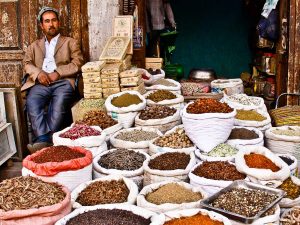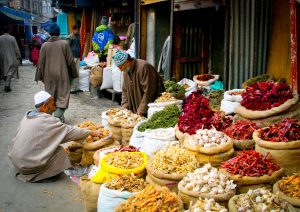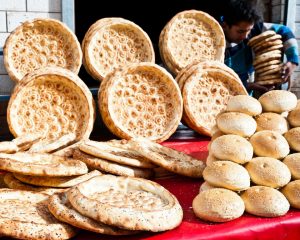Peace Watch » Kashmir-Talk, Perspectives » Nostalgia: Our Cultural Kinship with Kashghar
Nostalgia: Our Cultural Kinship with Kashghar
Nostalgia
Abdullah Nankabab Wala
ZGM
Sometimes, recalling my childhood, I start believing that every one of us in our right was a Michelangelo- ‘and for us, every block of stone had a statue in it,’ and sculptor inside us always discovered it. From a small grass shoot to a tiny attractive black and purple beetle moving gracefully underneath the turf everything around stimulated our imagination and we conjured a world of our own on our ‘mental-canvas.’ For children the small betel was “Khuda-Saban-Bata-Phol” (God’s tiny creation) – our elders had advised us not to hurt the insect. 
The vast lawns of the Martyrs graveyard, during those days of pure innocence, were our best playfield. Some fifty  meters away from this playfield, I was admitted to a government school. In this column, I have written couple of times earlier about my first day in the Kindergarten class. That for me was as good a wonderland as the loft of our three-story house. Besides, the gaudy clay models, tiny replicas of various mountain peaks of Kashmir and cardboard representations of historic Masjids and Khanqahs in the kindergarten class it was small cloth canopy on a clay platform outside the school that often caught my imagination. Those, where the days, when was yet to arrive in Srinagar, and small-time retailers during hot summers used sheets of white cloth as awnings for saving their goods from the scorching sun and during snow and rain, they covered their kiosks with tarred canvas. The vendor under the canopy used to sell roasted peas, soybeans, chickpea, sweet maize, and lentils. It cost one paisa to buy a pocketful of any of the roasted items. Close to him another vendor squatted on round hay-mat called Tchanigij with a huge willow basket filled with sizzling boiled chickpeas covered with a cloth –looking like a mini pyramid. Sometimes he sold boiled red beans spruced artistically with red ginger and chilly powder – and palmsful cost one or two paise.
meters away from this playfield, I was admitted to a government school. In this column, I have written couple of times earlier about my first day in the Kindergarten class. That for me was as good a wonderland as the loft of our three-story house. Besides, the gaudy clay models, tiny replicas of various mountain peaks of Kashmir and cardboard representations of historic Masjids and Khanqahs in the kindergarten class it was small cloth canopy on a clay platform outside the school that often caught my imagination. Those, where the days, when was yet to arrive in Srinagar, and small-time retailers during hot summers used sheets of white cloth as awnings for saving their goods from the scorching sun and during snow and rain, they covered their kiosks with tarred canvas. The vendor under the canopy used to sell roasted peas, soybeans, chickpea, sweet maize, and lentils. It cost one paisa to buy a pocketful of any of the roasted items. Close to him another vendor squatted on round hay-mat called Tchanigij with a huge willow basket filled with sizzling boiled chickpeas covered with a cloth –looking like a mini pyramid. Sometimes he sold boiled red beans spruced artistically with red ginger and chilly powder – and palmsful cost one or two paise.
It was an old book, ‘Kashmir and Kashghar’ written by H.W. Bellew forgotten for years on a bookshelf in my study that made me remember my early days at the school and the small-time vendors- that loomed large in our imagination. There was yet, another small time hawker who arrived from a distant Mohalla into our locality with his stuff, not in a willow but a wooden headload basket. Like a town crier, from a small antique tin megaphone he cried at his highest pitch; nankhatai, nankabab – Abaloun-Dabals Nanan-Kabab. His name was Abdullah which in typical Kashmiri style he had distorted as Abaloun– one paisa was also called Dabal-Paisa. Nankabab was small bread roll made from wheat flour spruced with sugar and nankhatai could be compared to cookies. He was short-statured, for his Chinese face and nose we called him as “bhota”- his forefathers had perhaps arrived into Kashmir from Kashgar. 
For his stuff, he was very popular with children. Then, none of us realized, he was our last connection with Kashgar; a land of great civilization as someone has said that “sits like a punctuation mark between China and Central Asia, along the Silk Road.” The centuries-old interface between Kashgar and Kashmir has wedded the two into such close cultural kinship that it is difficult to say which one has benefitted from whom. The traditional marketplaces of Kashmir and Kashgar seem replicas of each other. The bread of Kashgar known for their extraordinary variety is a replica of the wide assortment of Kashmir bread. Their giant flat hemek nan is comparable to Koshur-rooth,- even the large Kaisher Tchott can be compared to it, their ‘small fat bagels, gizdher, shining and sprinkled with sesame seeds is comparable to our traditional Tchochivour……..
Perhaps, it is thousands of people like Abdullah Nankabab Wala who have brought cultural kinship between Kashmir and Kashgar for centuries that survives even today.
Filed under: Kashmir-Talk, Perspectives







